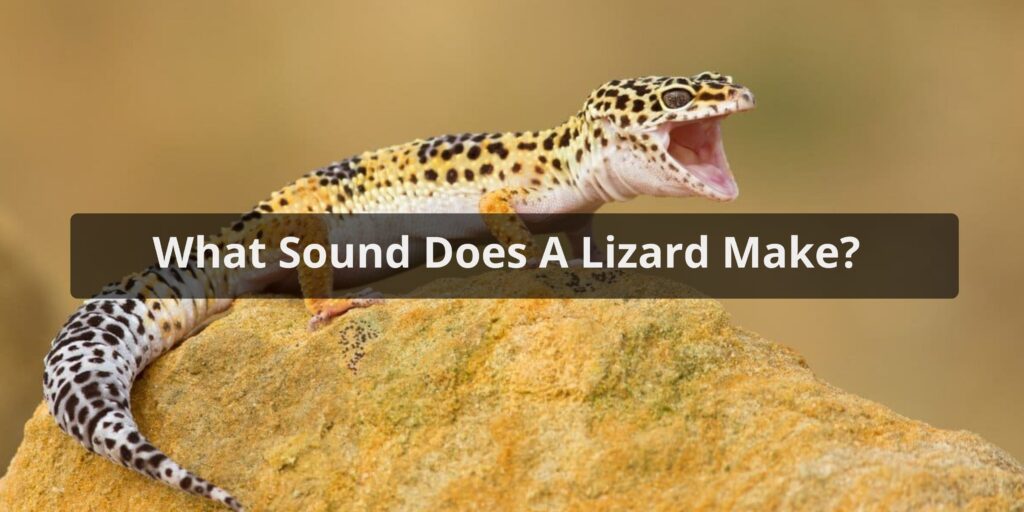Lizards are fascinating creatures that have inhabited the earth for over 200 million years. Their diversity in size, color, behavior, and habitat is immense. Over 6,000 lizard species exist in the world today. With so many types of lizards, the noises they make are just as varied. So what sound does a lizard make? Let’s explore the wide range of vocalizations these reptiles can create.
Vocalizations of Lizards
Lizards communicate through vocalizations, body language, pheromones, and visual displays. Their vocal repertoire includes chirps, croaks, hisses, and barks. The context of these sounds differs between species lizard, but some common reasons lizards vocalize are:
- Territorial warnings – Many lizards make loud chirping or hissing sounds to warn intruders away from their domain. Some also use body language like head-bobbing to issue their threats visually.
- Courtship calls – Male lizards vocalize to attract females during breeding season. These complex sounds are unique to each species.
- Distress calls – When threatened by predators, lizards give shrill alarm calls to either scare off the attacker or alert others to danger.
- Hatchling calls – Baby lizards peep or squeak to gain the attention of adults or locate clutch-mates after hatching.
Now let’s look at some specific examples of the diverse vocalizations lizards are capable of producing:
Gecko Chirping

Geckos are well known for the cute chirping noises they make. This sound is produced when the lizard forces air through the throat and slaps its tongue against the roof of its mouth. Chirps function as territorial displays to ward off competing geckos. The male mourning gecko wins the prize for the most repetitive vocalist – he can “bark” up to 6000 times per hour!
Iguana Hissing
The green iguana and spiny-tailed iguana hiss as part of their defensive repertoire. Air is forced through the throat to produce this raspy, menacing sound when threatened. Hissing often occurs together with mouth-gaping to look bigger and scarier to predators.
Chameleon Croaking
While chameleons are better known for their color changing abilities, male veiled and panther chameleons make loud, distinctive croaking sounds during courtship. Their specialized throat structure allows them to both vocalize and project these low-frequency croaks long distances to attract females.
Horned Lizard Squirting
The aptly named horned lizards of North America squirt blood from their eyes as a bizarre defensive tactic. This is accompanied by aggressive hissing and puffing themselves up to appear dangerous. Only the Texas horned lizard actually makes a squirting sound to startle predators. They force blood sinus pressure through ducts behind the eyes towards the attacker!
Monitor Lizard Hissing
Monitor lizards produce a trembling hiss reminiscent of a rattlesnake. Air passing through the vocal cords causes the hiss’s signature vibration. Monitors hiss as a warning and accompanies aggressive behaviors like head-bobbing, mouth-gaping, and inflating their bodies. Komodo dragons take monitor hissing to another level with their deeply ominous hissing rumble.
Leopard Lizard Barking
The southwestern leopard lizard squeaks, grunts, and most uniquely, barks! They make a series of rapid barking sounds when approached too closely. This serves to both startle predators and proclaim territory ownership. Their barks are produced by forcing air through closed jaws – a ability rare for lizards.
Baby Lizards Peeping
Newly hatched lizards issue high-pitched squeaks or peeps to attract parental care, find clutch-mates, or warn of danger. Examples include the shrill baby bearded dragon squeal, the loud pleading peeps of baby green iguanas, and the ticking distress calls of young geckos when separated from the group.
Conclusion
What sound does a lizard make? A vast diversity of chirps, hisses, barks, and more! Over thousands of lizard species, vocalizations have evolved to serve key functions like warning off enemies, attracting mates, claiming territory, and even startling predators. Whether it’s the comical chirping of geckos or ominous hissing of monitors, lizards have developed unique mechanisms to produce their mesmerizing sounds. When you hear a lizard’s vibrant vocalizations, take a moment to appreciate the story their sounds tell!
FAQs About What Sound Does a Lizard Make
Can lizards produce vocalizations or noises?
Lizards are indeed capable of producing various vocalizations and noises. While they lack vocal cords like mammals, many species can generate sounds through unique mechanisms. These sounds can serve communication, mating, territory marking, and signaling purposes, enhancing their interactions in the ecosystem.
Do different species of lizards make different sounds?
Absolutely, different species of lizards exhibit a wide array of sounds. The sounds can vary in frequency, duration, and complexity, reflecting the diverse ecological niches they inhabit. Some produce clicks, hisses, chirps, or even musical tones, each tailored to their specific communication needs.
What is the purpose of the sounds lizards make?
The sounds produced by lizards serve multifaceted purposes. Primarily, these sounds are used for communication, enabling lizards to establish territories, attract mates, warn off predators, and convey aggression. These auditory cues play a crucial role in their survival, reproduction, and interactions within their environment.
Are the sounds of lizards considered musical or rhythmic?
While the sounds lizards make may not be perceived as conventionally musical, they do exhibit distinct rhythms and patterns. Some species produce repetitive calls that can be considered rhythmic in nature. However, the musicality of these sounds is often subjective and influenced by cultural interpretations.
What factors can influence the sounds lizards produce?
Several factors can influence the sounds lizards produce. These include environmental conditions, such as temperature and humidity, which can affect sound transmission. Additionally, the presence of potential mates, rivals, or predators can trigger varying types of vocalizations. Lizards’ physical characteristics and evolutionary history also play a role in determining their sound-producing abilities.



